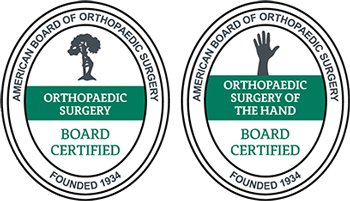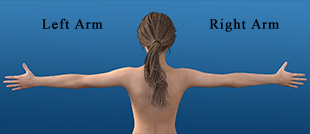Radial Tunnel Syndrome
Contents
- 1 What is Radial Tunnel Syndrome?
- 2 What causes Radial Tunnel Syndrome?
- 3 What Are the Symptoms of Radial Tunnel Syndrome?
- 4 How is Radial Tunnel Syndrome diagnosed?
- 5 How is Radial Tunnel Syndrome treated?
- 6 How can Dr. Knight help you with radial tunnel syndrome?
- 7 Radial Tunnel Syndrome Fact Sheet
- 8 Frequently Asked Questions:
- 9 Videos
- 10 Animated Videos
- 11 Surgical Videos
What is Radial Tunnel Syndrome?
The radial nerve is one of three nerves that provide motor and sensory function to the arm. The radial nerve begins at the brachial plexus and extends downward to the wrist and into the hand. As it travels down the arm, it branches several times to provide movement to the muscles of the dorsal arm and sensation to the skin covering the forearm and the back of the hand. This nerve is responsible for extension of the arm, wrist and finger and supination (outward rotation) of the forearm. Compression of the radial nerve results in Radial Tunnel Syndrome. Compared to Cubital Tunnel Syndrome and Carpal Tunnel Syndrome, Radial Tunnel Syndrome is the least common.

What causes Radial Tunnel Syndrome?
At the lateral aspect of the elbow, the radial nerve branches into the posterior interosseous nerve (PIN) and enters the radial tunnel. The radial tunnel (arcade of Frohse) is formed by bone and the muscles used for the supination of the forearm. Radial Tunnel Syndrome occurs most frequently from compression in the proximal forearm associated with these muscles. Bone fractures, trauma to the soft tissues surrounding the nerve, or repetitive motion resulting in inflammation of the muscle can all result in Radial Tunnel Syndrome.

What Are the Symptoms of Radial Tunnel Syndrome?
The most common symptom is pain in the forearm a couple of inches below the elbow. Generally, the pain will increase with activity, heavy lifting, or by extending the elbow and pronating (inward rotation) the forearm. The pain can be described as achy, and is occasionally associated with muscle weakness and may worsen at night. Radial Tunnel Syndrome is often confused with Tennis Elbow, so accuracy is important when describing symptoms.
How is Radial Tunnel Syndrome diagnosed?
In addition to a detailed history of pain, symptoms, and activity, physical examination and testing may be required. Determining the precise location of the pain is important for proper diagnosis. Localized tenderness to the entrance of the radial tunnel should be compared bilaterally along with the radial head and lateral epicondyle. The physician may extend and maneuver the arm to compare pain levels during pronation and supination or resistance to these motions. X-rays of the elbow, MRI of the cervical spine, electromyography, and nerve conduction studies may also be helpful for a definitive diagnosis.
How is Radial Tunnel Syndrome treated?
Non-surgical
In cases where Radial Tunnel Syndrome is caused by repetitive motion injury, the simplest and most effective treatment is to avoid or modify the causative movement. Increased rest and splinting the arm can be quite helpful. Limit heavy pulling, pushing, twisting, or grasping, which can aggravate symptoms. Physical therapy involving exercises, stretching, electrical stimulation, or ice may relieve pain. Over-the-counter or prescription NSAIDs (i.e., ibuprofen and naproxen) can also ease pain and reduce inflammation.
Surgical
When non-surgical methods fail to provide adequate relief or pain returns shortly after beginning activity, it may be time to consider surgical decompression. The goal is to release abnormal pressure points as the radial nerve passes through the radial tunnel. An incision is made at the outer aspect of the forearm near the elbow. The muscle tissues are manipulated so the surgeon can visualize any pressure points where the nerve is pinched. The tunnel is expanded in those areas, relieving pressure and pain.
This procedure can be outpatient; the client goes home in a long arm splint. In 8-10 days, the patient returns for suture removal and placement of a removable splint. In two more weeks therapy begins, and the removable splint is only worn when not active and at night. Therapy lasts approximately two months.

How can Dr. Knight help you with radial tunnel syndrome?
Dr. Knight will look at all possible causes of pain in your forearm from the neck down. Once he confirms the diagnosis, he will work with you to maximize conservative treatment to relieve your symptoms. He will only recommend surgery for this condition if exhaustive conservative care has failed. If radial tunnel surgery is needed, Dr. Knight will perform as minimally invasive procedure as necessary to minimize scarring and expedite a full recovery.
See Dr. Knight, one of the best hand surgeons in Dallas, and see if he can help you live a more pain-free life. Come to our Southlake hand and wrist center or Dallas Fort-Worth-friendly office location.
Radial Tunnel Syndrome Fact Sheet
| What are the most common factors that lead to Radial Tunnel Syndrome? | Most often, repetitive motion leads to the inflammation of the radial tunnel, which then creates friction on the radial nerve, and leads to the symptoms of the condition. This can be the result of work activities such as typing or other intense use of the hands and wrists, such as sports or hobbies. |
| How can I avoid getting Radial Tunnel Syndrome or lessen the symptoms once it starts? | Cutting down on the actions that have led to the development of the condition is the primary method of self-treatment of Radial Tunnel Syndrome. Avoiding pulling, pushing, manipulation, grasping, and twisting are very important parts of this kind of treatment. rest and icing are also effective methods of reducing the inflammation of the radial tunnel. |
| Are there medications I can take? | Anti-inflammatory medications are important for reducing the swelling that typifies the condition and reducing stress on the radial nerve. In later stages, pain relief may be necessary depending on the type of pain developed in the extremity. |
| How long am I going to have Radial Tunnel Syndrome? Can it be cured? | If left untreated and no modification in activity is undertaken, then Radial Tunnel Syndrome will continue to develop. This will lead to a more significant deterioration of sensation and use of the limb, reducing productivity and your ability to engage in daily activities. |
| What are the most effective ways to treat Radial Tunnel Syndrome? | Physical therapy, oral NSAIDs, and ergonomic modification are the most commonly used conservative treatments. Failing these, surgery can open up the radial tunnel in a procedure known as decompression, relieving the nerve’s pressure. |
Frequently Asked Questions:
How long does Radial Tunnel Syndrome last?
This is a difficult question because many factors come into play when discussing the length of time that a nerve condition like Radial Tunnel Syndrome might last. If treated early and appropriately, the symptoms can be alleviated, and further complications can be avoided. Still, usually, by the time someone notices the pain associated with the condition, it has progressed enough that medical intervention is necessary. With conservative treatment, the symptoms of the condition can be lessened. Still, you must maintain these activities to keep the condition from worsening. If they do not prove effective, surgery may be necessary, which has a different recovery time.
What happens if my Radial Tunnel Syndrome goes untreated?
As a nerve-related condition, Radial Tunnel Syndrome can cause great pain, and so if it is untreated, this pain will increase. Swelling and numbness are also symptoms that will make it difficult to use your arm in daily activities, and the longer they go untreated, the harder it will be to get things done. As soon as you think you may be suffering from Radial Tunnel Syndrome, it is important to seek treatment to avoid this eventuality.
Do I need surgery to get rid of Radial Tunnel Syndrome?
Dr. Knight always prefers conservative treatment before resulting in surgery. Still, in cases where conservative treatment proves ineffective, surgery might be necessary to give you the relief you need and return the functionalist to the affected area. Surgery is a relatively simple procedure known as decompression, where the Radial Tunnel is incised to relieve pressure on the nerve. After a two-month recovery period with therapy, you should be free of pain and able to return to daily activities.
Is Radial Tunnel Syndrome painful?
Yes. Radial Tunnel syndrome involves the radial nerve, and any condition that affects the nerves will have sensory symptoms, which include pain. They may also include tingling and numbness, but the pain will be the most noticeable of the symptoms.
Videos
Animated Videos
Surgical Videos
Note: The following videos contain graphic images.
Disclaimer
HandAndWristInstitute.com does not offer medical advice. The information presented here is offered for informational purposes only. Read Disclaimer

























